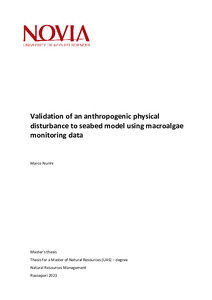Validation of an anthropogenic physical disturbance to seabed model using macroalgae monitoring data
Nurmi, Marco (2023)
Julkaisun pysyvä osoite on
https://urn.fi/URN:NBN:fi:amk-2023121738012
https://urn.fi/URN:NBN:fi:amk-2023121738012
Tiivistelmä
This thesis explores marine cumulative impact assessment models and their validation. The aim was to validate a cumulative physical disturbance to seabed GIS model with linear regression, encompassing the entire Finnish marine area. National and Helsinki macroalgae monitoring data was used as dependent variables. Each national monitoring site included Fucus vesiculosus ecological quality rating (EQR) data, while each Helsinki site contained F. vesiculosus EQR and combined macroalgae EQR data. The thesis also summarises five papers where validation was attempted.
The cumulative physical disturbance spatial model used as the independent variable included the physical disturbance estimates of 13 different human activities. In addition to the physical disturbance model, a turbidity model and two distance-based variables were also included as independent variables, to compare statistical significance and predictive power. Numerous linear regression analyses were preformed, with differing input data combinations.
Results show no statistical significance with physical disturbance to seabed as the only predictor for the national sites, probably due to limited human activity near the sites. For the Helsinki sites results showed statistical significance (p < 0.05), with R2 at best = 0.435. With both turbidity and physical disturbance as independent variables, the highest R2 was 0.693 (Helsinki). The highest R2 values were achieved when only the most prevalent human activities at the sites were included.
The cumulative physical disturbance spatial model used as the independent variable included the physical disturbance estimates of 13 different human activities. In addition to the physical disturbance model, a turbidity model and two distance-based variables were also included as independent variables, to compare statistical significance and predictive power. Numerous linear regression analyses were preformed, with differing input data combinations.
Results show no statistical significance with physical disturbance to seabed as the only predictor for the national sites, probably due to limited human activity near the sites. For the Helsinki sites results showed statistical significance (p < 0.05), with R2 at best = 0.435. With both turbidity and physical disturbance as independent variables, the highest R2 was 0.693 (Helsinki). The highest R2 values were achieved when only the most prevalent human activities at the sites were included.
